Matcha
Matcha Vs Matcha Latte: Unveiling the Differences

Welcome, fellow matcha enthusiasts, to the ultimate showdown: Matcha vs Matcha Latte! Like the yin and yang, these two delightful concoctions are closely related yet distinct in their own ways.
Matcha, a vibrant green powder made from finely ground tea leaves, is known for its earthy and grassy flavors. On the other hand, its counterpart, the matcha latte, offers a luscious and creamy twist, blending the richness of milk with the invigorating essence of matcha.
As we delve deeper into this battle, we will explore the health benefits of both matcha and matcha latte, compare their tastes side by side, and even share techniques for crafting the perfect cup of each.
So, grab your whisk and prepare to embark on a journey of matcha mastery!
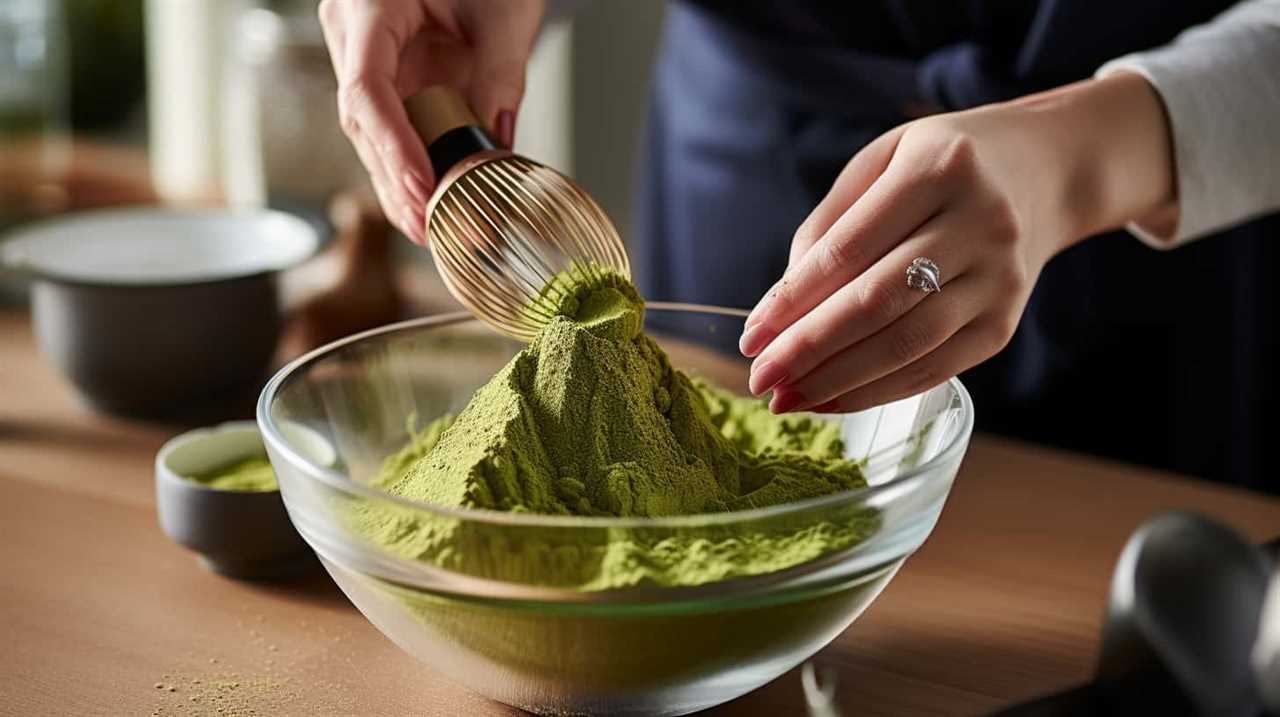
Key Takeaways
- Matcha is a powdered green tea made from finely ground tea leaves.
- Matcha latte combines matcha powder with milk to create a creamy and frothy beverage.
- Matcha is rich in antioxidants called catechins, which help protect against free radicals.
- Matcha latte offers a unique twist on the health benefits of matcha.
What Is Matcha
Matcha is a type of powdered green tea that’s made from finely ground tea leaves. It’s known for its vibrant green color and unique flavor profile.
Matcha cultivation requires meticulous care and attention to detail. The tea leaves are shade-grown for several weeks before harvesting, which helps to enhance their flavor and increase the production of chlorophyll. After harvesting, the leaves are carefully steamed, dried, and ground into a fine powder.
The quality of matcha can vary depending on several factors, including the grade of the tea leaves used. Matcha grades are determined by factors such as the age of the leaves, cultivation methods, and processing techniques. Higher grade matcha tends to have a smoother, sweeter taste and a brighter green color.
Now, let’s explore how matcha latte is different from traditional matcha.
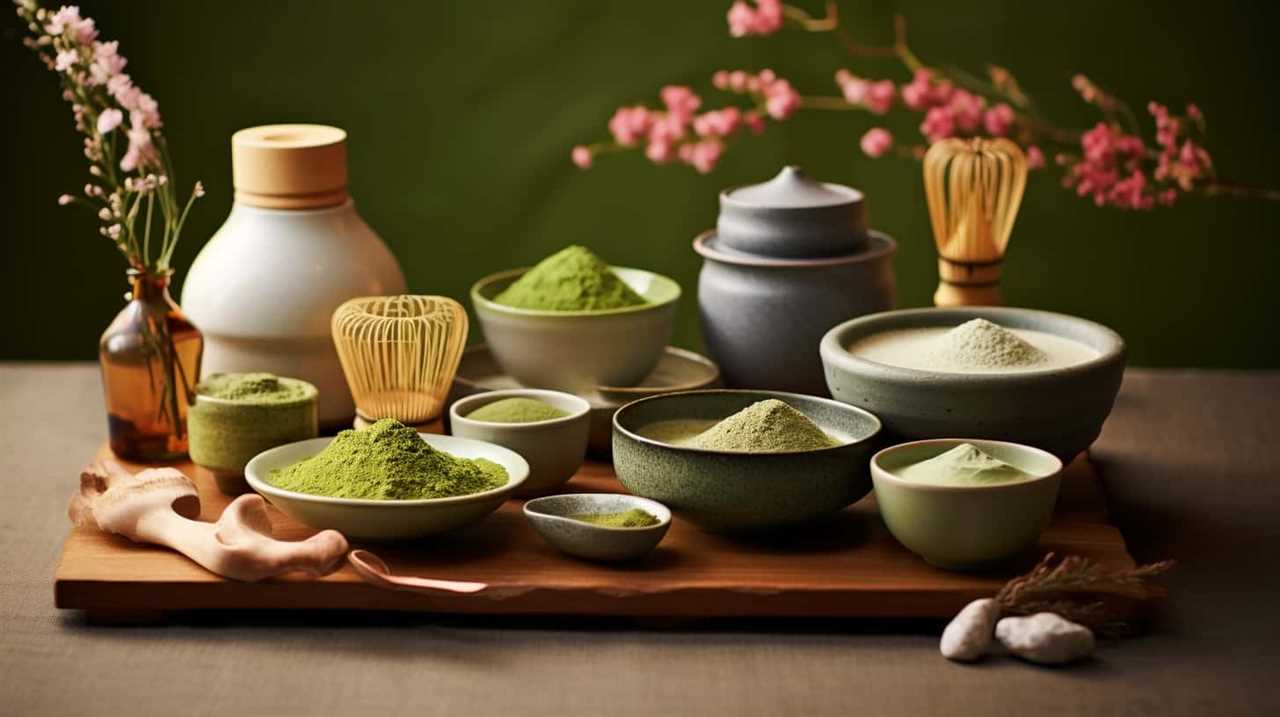
How Is Matcha Latte Different
When making a matcha latte, we combine matcha powder with milk to create a creamy and frothy beverage. Unlike traditional matcha, which is simply whisked with hot water, the addition of milk in a matcha latte creates a richer and smoother texture.
Matcha latte variations have become increasingly popular, with different types of milk, such as almond or oat milk, being used as alternatives to traditional dairy. Additionally, sweeteners like honey or agave syrup can be added to enhance the flavor.
Matcha powder can also be used in various other ways, such as in baking or cooking, to add a vibrant green color and unique flavor to dishes.
Now, let’s explore the health benefits of matcha and why it has gained so much attention in recent years.
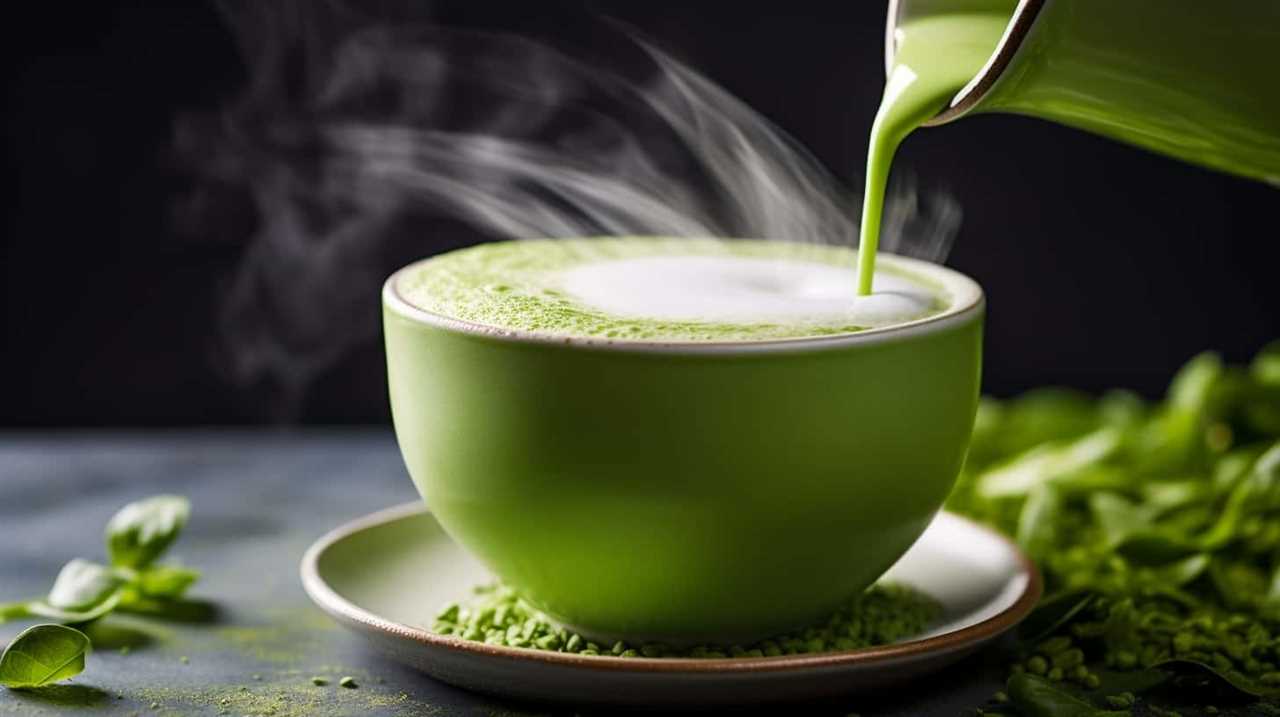
Health Benefits of Matcha
One of the key reasons why matcha and matcha latte have gained popularity in recent years is due to the numerous health benefits they offer.
Matcha, a finely ground powdered green tea, is rich in antioxidants called catechins, which help protect the body against damage from free radicals. These antioxidants have been associated with a reduced risk of chronic diseases, such as heart disease and cancer.
Additionally, matcha contains a compound called EGCG (epigallocatechin gallate), which has been found to boost metabolism and aid in weight loss.
Matcha can be enjoyed not only as a traditional tea but also incorporated into various recipes like smoothies, desserts, and even savory dishes.

Its versatility and potential health benefits make matcha a popular choice for those seeking to improve their overall well-being.
Health Benefits of Matcha Latte
Moving on to the health benefits of matcha latte, we can see that it offers a unique twist on the already impressive advantages of matcha.
Matcha latte, made by combining matcha powder with hot milk or milk alternatives, provides a multitude of health benefits.
Like regular matcha, matcha latte is rich in antioxidants called catechins, which help protect the body against free radicals and promote overall well-being.

Additionally, matcha latte can aid in weight management, as it contains a compound called EGCG that can boost metabolism and assist in burning fat.
Moreover, matcha latte alternatives, such as almond milk or oat milk, can further enhance the health benefits by providing additional nutrients like calcium and fiber.
To enjoy the health benefits of matcha latte, try incorporating it into your daily routine by exploring various matcha recipes and experimenting with different milk alternatives.
Taste Comparison: Matcha Vs Matcha Latte
Now let’s delve into the taste comparison between matcha and matcha latte. When it comes to taste preferences, matcha and matcha latte offer different experiences. Here are three key points to consider:
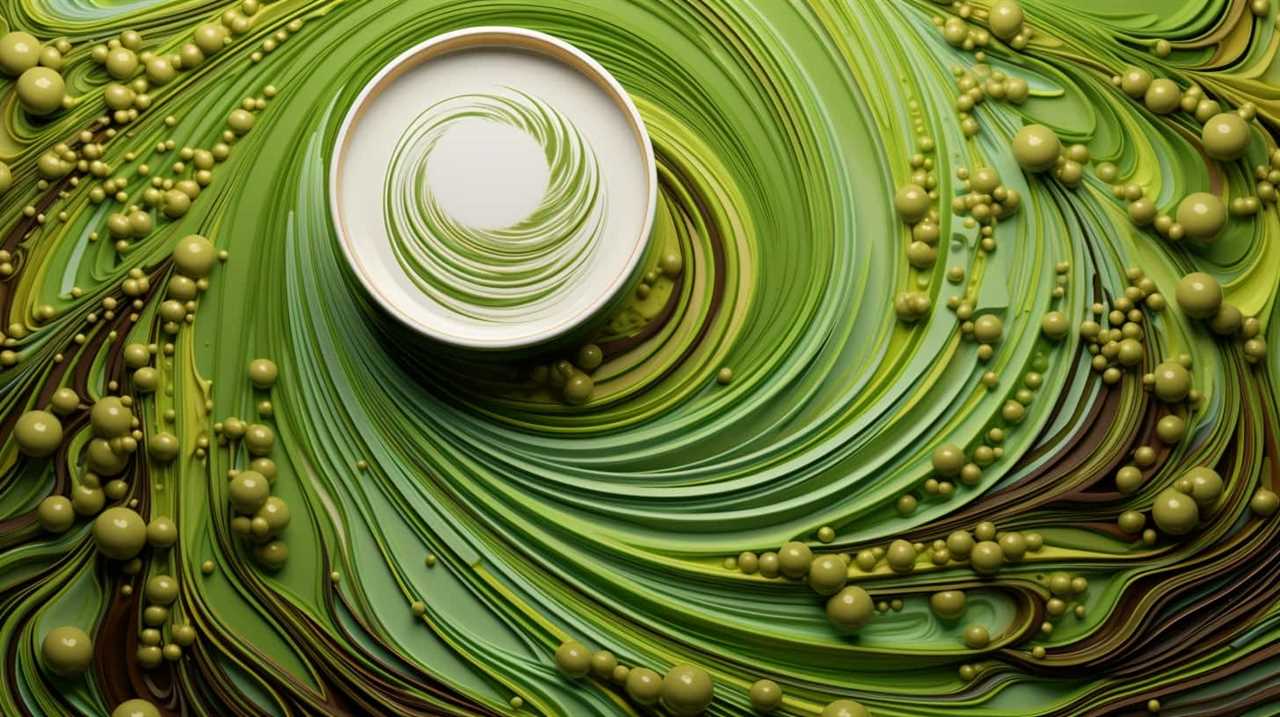
- Matcha: Pure matcha has a vibrant and robust flavor with a rich umami taste. It has a slightly bitter and vegetal profile that’s often described as earthy or grassy. This unique taste is highly valued by matcha enthusiasts who appreciate its natural complexity.
- Matcha Latte: On the other hand, matcha latte combines the distinct flavor of matcha with the creaminess of milk. The addition of sweeteners, such as honey or sugar, can further enhance the taste. The resulting drink is smooth, creamy, and mildly sweet, making it a popular choice for those who prefer a milder taste.
These taste profiles can be further customized with various matcha recipes, allowing individuals to tailor the flavor to their liking. Whether you prefer the boldness of pure matcha or the creamy sweetness of a matcha latte, there’s a taste that suits every palate.
How to Make a Perfect Matcha
When it comes to making a perfect matcha, mastering the whisking technique is essential. The way you whisk the matcha powder with hot water can greatly affect the taste and texture of the final product.
Additionally, choosing the right matcha brand can make a significant difference in the quality and flavor of your matcha.
Lastly, there are traditional and modern methods of making matcha, each with its own unique characteristics and benefits.
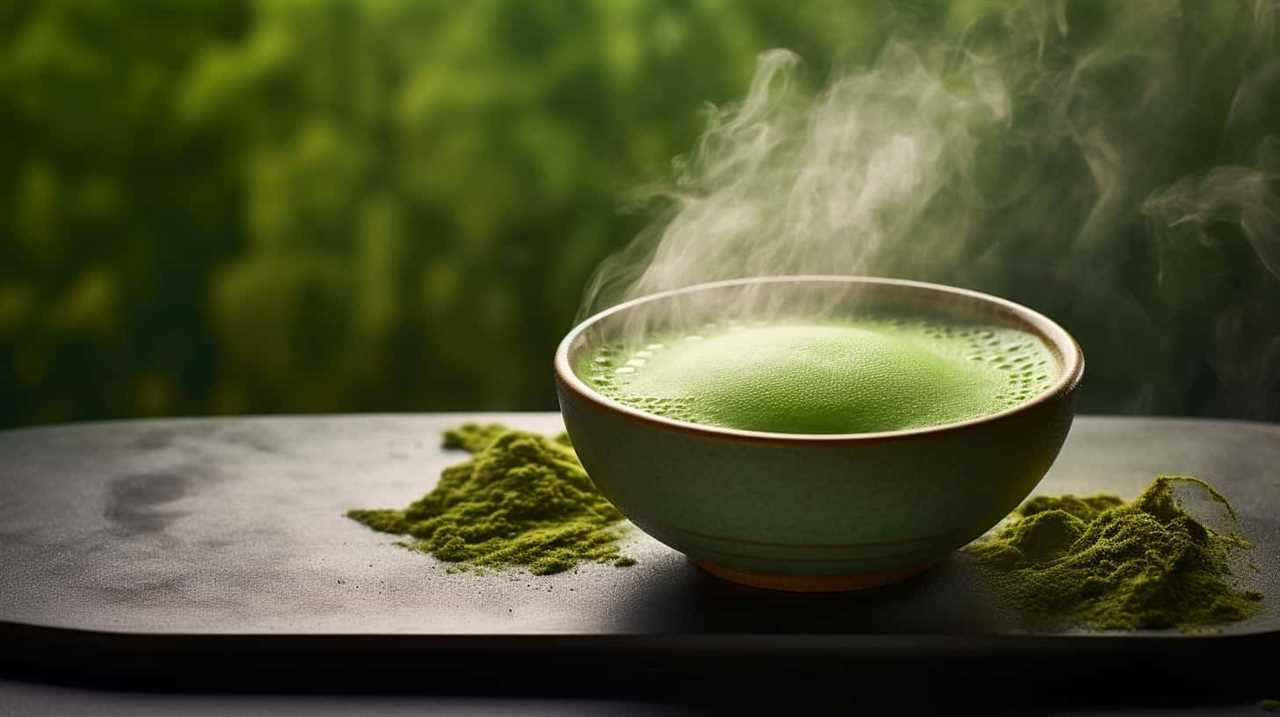
Whisking Techniques for Matcha
To achieve a perfect matcha, we must master the whisking techniques. Whisking is a crucial step in preparing matcha as it helps to create a smooth and frothy texture while enhancing the flavor. Here are three different whisking techniques and frothing methods that can elevate your matcha experience:
- Traditional Whisking: This method involves using a bamboo whisk (chasen) to whisk the matcha in a zig-zag motion until it becomes frothy. It requires a bit of practice to achieve the desired consistency, but it results in a rich and creamy matcha.
- Electric Whisking: Using an electric whisk can be a convenient and efficient way to froth matcha. Simply place the matcha and water in a bowl and whisk it on low speed until frothy. This method is perfect for those who want a quick and effortless matcha preparation.
- Frother Whisking: A milk frother can also be used to whisk matcha. Add the matcha and water in a container, place the frother inside, and whisk it until it becomes frothy. This method is ideal for those who prefer a lighter and less creamy matcha.
Mastering these whisking techniques will help you create a perfect matcha every time, ensuring a delightful and satisfying matcha experience. Now, let’s move on to explore the best matcha brands to further enhance your matcha journey.
Best Matcha Brands
Let’s dive into exploring the best matcha brands and how we can make a perfect matcha.
When it comes to choosing the best matcha brand, it’s important to consider factors such as quality, taste, and sourcing. Some top matcha brands known for their exceptional quality include Ippodo Matcha, Mizuba Tea Co., and Aiya Matcha. These brands offer a range of matcha options, from ceremonial grade to culinary grade, allowing you to choose the one that suits your needs.

In order to make a perfect matcha, it’s crucial to follow the right preparation techniques. From whisking to water temperature, every step plays a significant role in enhancing the flavor and texture of your matcha.
Experimenting with different matcha latte variations and best matcha recipes can also elevate your matcha experience.
Traditional Vs Modern Methods
We prefer using traditional methods to make a perfect matcha. Traditional methods have been used for centuries and have proven to bring out the best flavors and qualities of matcha. Here are some key reasons why traditional methods are preferred:
- Shade Grown Leaves: Matcha made using traditional methods comes from tea leaves that are grown in the shade, which enhances the production of chlorophyll and amino acids.
- Stone Grinding: Traditional matcha is made by stone grinding the tea leaves into a fine powder, resulting in a smooth and creamy texture.
- Ceremonial Preparation: Traditional methods involve a ceremonial preparation process, which allows for a mindful and meditative experience while making matcha.
By using traditional methods, we ensure that the matcha is of the highest quality and provides an authentic taste.
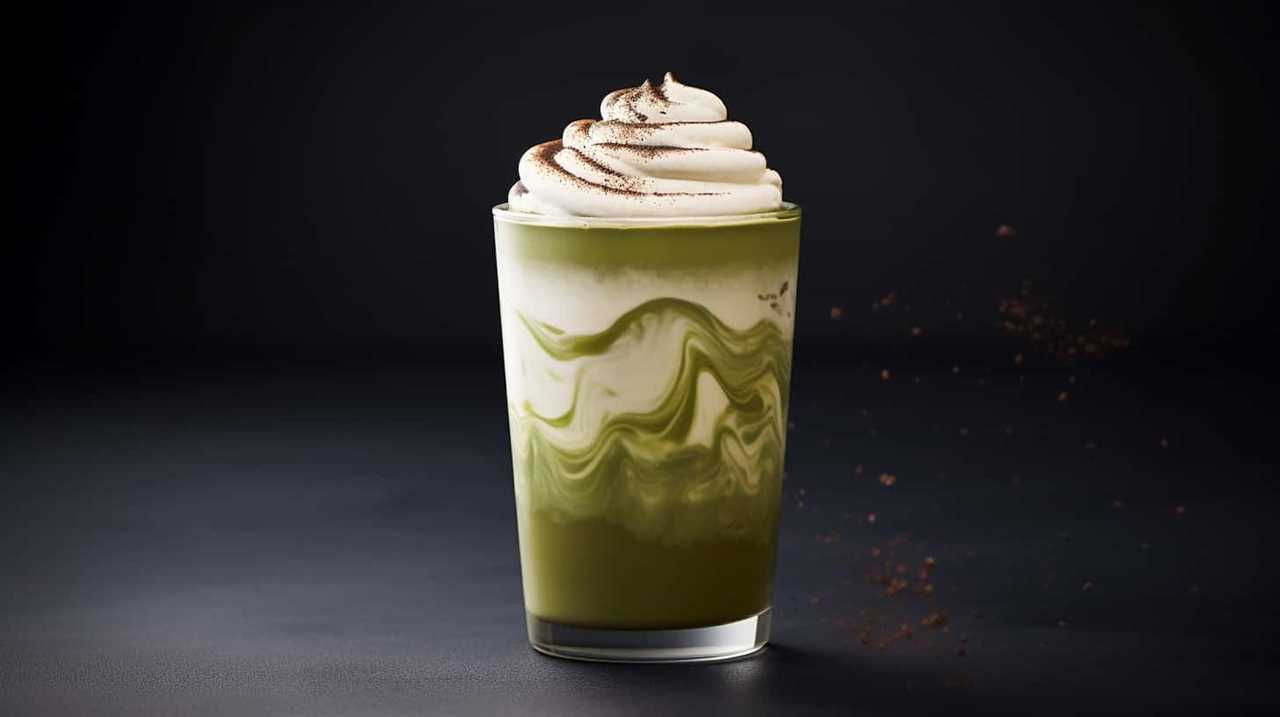
Now, let’s dive into how to make a delicious matcha latte.
How to Make a Delicious Matcha Latte
Making a delicious matcha latte involves carefully whisking the matcha powder into a smooth and frothy mixture.
To begin, choose a high-quality matcha powder that’s vibrant green in color and has a rich aroma. Sift the matcha powder into a bowl to remove any clumps and ensure a smoother texture.
Heat a small amount of water, just below boiling, and pour it over the matcha powder. Use a bamboo whisk to vigorously whisk the mixture in a zigzag motion until it becomes frothy and well combined.

Once the matcha is whisked, heat your milk of choice and pour it over the matcha mixture. For variations, you can add a touch of honey or vanilla extract for sweetness, or experiment with different types of milk like almond or oat.
Enjoy your homemade matcha latte and savor the unique flavors and health benefits it offers.
Frequently Asked Questions
Can Matcha Latte Be Made With Regular Green Tea Instead of Matcha Powder?
Yes, regular green tea can be substituted for matcha powder in a matcha latte. However, it will not provide the same unique flavor and health benefits that matcha offers, such as higher antioxidants and a more vibrant taste.
What Is the Caffeine Content in Matcha Compared to Matcha Latte?
When comparing the caffeine content of matcha and matcha latte, it’s important to note that matcha itself contains more caffeine than a matcha latte. However, the health benefits of matcha make it a popular choice.
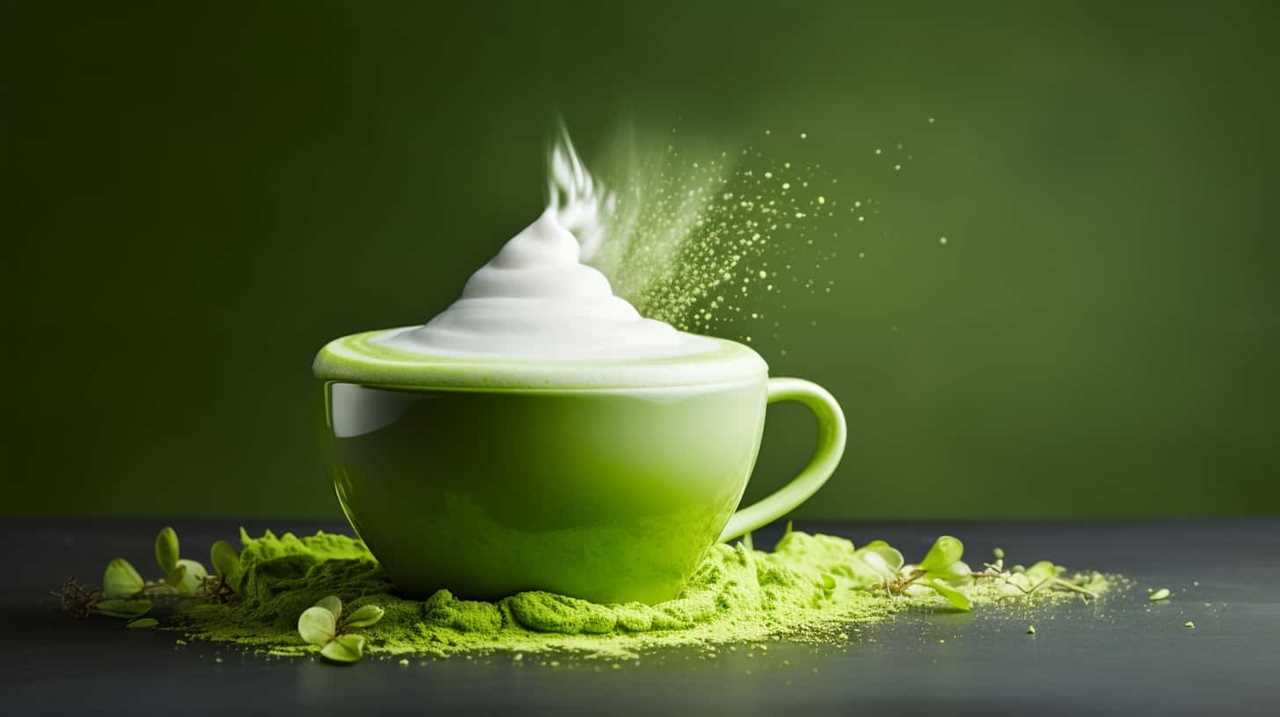
Can Matcha Be Used in Other Recipes Besides Matcha Latte?
Yes, matcha can be used in a variety of recipes beyond matcha lattes. It adds a unique flavor and vibrant green color to desserts, smoothies, ice creams, and even savory dishes like noodles or salad dressings. The versatility of matcha is truly remarkable.
Does Matcha Latte Contain the Same Antioxidants as Regular Matcha?
Matcha latte contains the same antioxidants as regular matcha. This means that, in addition to its potential health benefits, it also provides a delicious alternative to consuming matcha in its pure form.
Are There Any Potential Side Effects of Consuming Matcha or Matcha Latte?
There may be potential health risks associated with consuming matcha or matcha latte, including gastrointestinal issues, caffeine sensitivity, and risk of heavy metal contamination. Long-term effects are still being studied.
Conclusion
In conclusion, matcha and matcha latte offer distinct flavors and health benefits.

While matcha is a vibrant and earthy powdered green tea, matcha latte combines the richness of matcha with the creaminess of milk.
Both options provide numerous health advantages, such as boosting metabolism and providing antioxidants.
Like two sides of the same coin, matcha and matcha latte offer unique experiences that cater to different tastes and preferences, making them a delightful treat for tea enthusiasts.
So go ahead, indulge in a cup and let the flavors transport you to a world of blissful serenity.
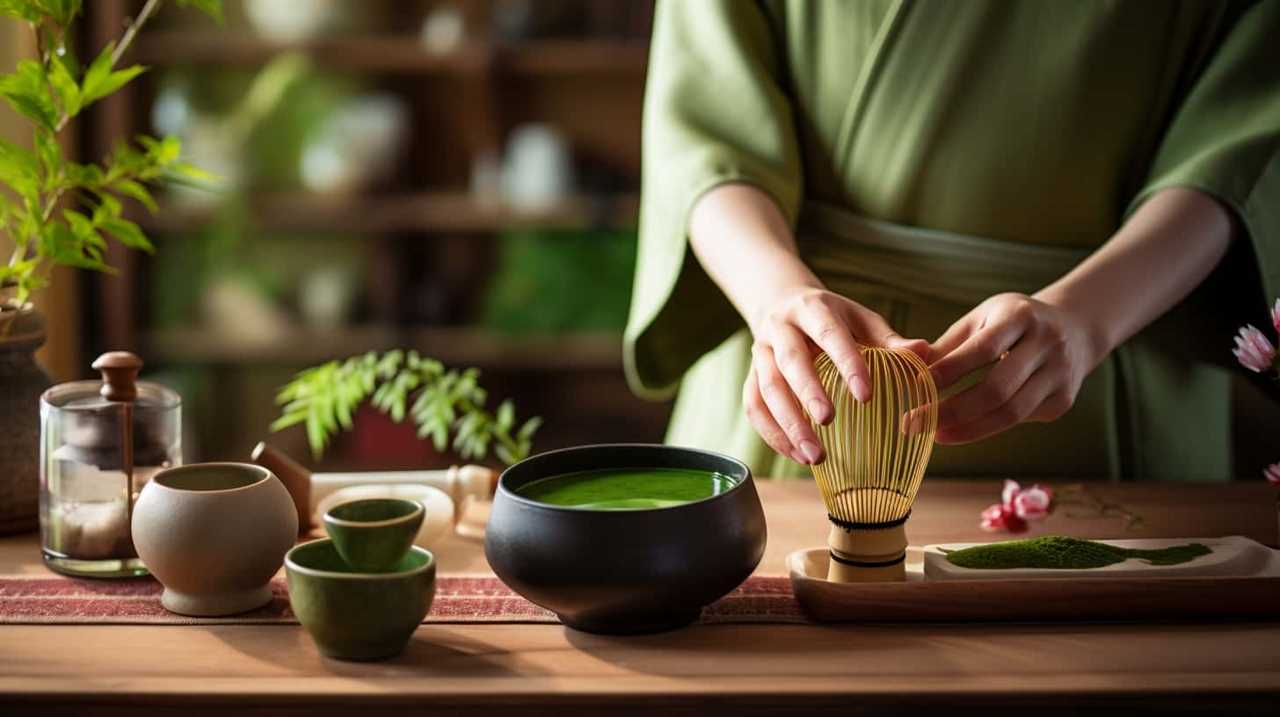
Justin is a seasoned author, coffee and tea enthusiast, and an essential member of the Cappuccino Oracle team. With a keen appreciation for the complexities of coffee, coffee alternatives, and tea, Justin has dedicated his professional career to exploring these realms and sharing his insights with readers worldwide.
Justin’s immersion in the world of coffee, coffee alternatives, and tea began at a young age, kindling a passion that extended beyond mere consumption. This love for these beverages led him to combine his talent for writing with his devotion to coffee and tea, bringing him to Cappuccino Oracle as a dedicated author.
Matcha
Unveiling The Mysteries Of Matcha: Insights On Its Origins, Production, And Quality

Have you ever been curious about the mysteries behind the rich and natural flavors of matcha? If so, get ready to join me on an adventure as we uncover the secrets of matcha, delving into its origins, production, and quality.
As a lover of all things tea, I have delved deep into the world of matcha, immersing myself in its rich history and intricate production process. From the shade-grown tea leaves to the meticulous grinding technique, every step is a labor of love that culminates in the velvety smooth powder we know as matcha.
Join me as we unravel the secrets behind this ancient Japanese tradition and discover why quality is key when indulging in this verdant elixir. We’ll explore the nuances of flavor, the importance of sourcing, and even delve into the fascinating world of other tea varieties.
So grab a cup, sit back, and let’s dive into the captivating world of matcha.
Key Takeaways
- Matcha tea is made from powdered green tea leaves and has a long and labor-intensive production process.
- Premium matcha is made from the first harvest in early spring, using the top 3 sprouts of the tea plant and ground tencha leaves.
- Cheaper matchas may skip some steps in the production process and are more suitable for matcha lattes.
- High-quality matcha is recommended for sparing consumption, as it has a smoother flavor and more health benefits compared to cheaper matchas.
What is matcha?
I’ve learned that matcha is a powdered green tea made from special tea leaves that are shaded before harvest, and it has a long and labor-intensive production process.
There are different types of matcha available, but the premium matcha is made from the first harvest in early spring, using only the top 3 sprouts of the tea plant. The leaves are then steamed, dried, and have their stems removed before being ground into a fine powder using a specialized mill made of granite.
It’s important to note that high-quality matcha is recommended for sparing consumption, as it has a complex production process that results in a smooth flavor. Matcha also offers various health benefits, such as being rich in antioxidants, boosting metabolism, and improving mental alertness.
Production process
The matcha production process involves shading the tea leaves before harvest and selecting the top three sprouts of the tea plant for premium matcha. Shading is a technique used to enhance the flavor and quality of the tea leaves. By covering the tea plants with shade, the leaves produce more chlorophyll and amino acids, resulting in a vibrant green color and a rich, umami taste.
After the shading period, only the top three sprouts of the tea plant are carefully handpicked for premium matcha. These selected leaves, known as tencha leaves, are then steamed, dried, and have their stems removed.
Finally, the tencha leaves are ground into a fine powder using a specialized granite mill. This process results in the smooth and concentrated matcha powder that we enjoy.
Quality and consumption
Let me tell you, indulging in high-quality matcha is like sipping a vibrant green elixir that awakens your taste buds and nourishes your body with its rich flavor and numerous health benefits. Matcha’s health benefits are truly remarkable. Packed with antioxidants, vitamins, and minerals, matcha is known to boost metabolism, enhance focus and concentration, and strengthen the immune system.
But not all matcha is created equal. Different grades of matcha exist, ranging from ceremonial grade to culinary grade. Ceremonial grade matcha is made from the highest quality tencha leaves and has a smooth, vibrant green color and a delicate, umami flavor. It is best enjoyed on its own, whisked with hot water.
On the other hand, culinary grade matcha is more affordable and is suitable for making matcha lattes, smoothies, and baked goods. Although it may have a slightly bitter taste and a duller color, it still provides health benefits.
So, whether you choose to indulge in high-quality ceremonial grade matcha or opt for the more affordable culinary grade, incorporating matcha into your routine is a delicious way to reap its health benefits.
Frequently Asked Questions
What are some popular ways to enjoy matcha besides drinking it as tea?
Besides drinking matcha as tea, some popular ways to enjoy it include indulging in matcha desserts like matcha ice cream, matcha cake, and matcha cookies. Additionally, matcha smoothies are a refreshing and healthy option.
Are there any specific health benefits associated with consuming matcha?
I’m no expert, but matcha is said to have potential health benefits. Some claim it can aid in weight loss due to its high antioxidant content and metabolism-boosting properties. However, more research is needed to confirm these claims.
How does the quality of matcha affect its flavor and overall experience?
The quality of matcha directly affects its flavor and overall experience. Higher quality matcha, made from carefully selected leaves and processed with precision, offers a smoother and more vibrant flavor, while lower quality matcha may have a less appealing taste and color.
Can matcha be used in cooking or baking?
"Where there’s matcha, there’s a way! Matcha can be used in a variety of cooking and baking recipes, adding a vibrant green color and a unique earthy flavor to dishes like matcha desserts."
Are there any specific tips or techniques for properly preparing matcha tea at home?
To properly prepare matcha tea at home, start by sifting the matcha powder to remove any clumps. Then, choose water at around 175°F to 180°F for the best flavor. Gradually add water to the matcha and whisk in a "W" or "M" motion until frothy. Enjoy!
Conclusion
In conclusion, matcha tea is not just a beverage, but a rich and fascinating tradition that has evolved over centuries.
From its origins in Japan to its intricate production process, matcha is a labor of love.
The quality of matcha is crucial, as the steps taken in its production directly impact its flavor and aroma.
Whether you’re a matcha connoisseur or a beginner, there is a matcha tea out there for you.
So, why not indulge in a cup of this vibrant green elixir and experience the magic of matcha for yourself? It’s a journey worth embarking on!
Arf, an author and an innovative enthusiast of coffee, coffee alternatives, and tea, plays a crucial role as a contributor to the esteemed Cappuccino Oracle platform. Renowned for his curiosity and passion for these captivating beverages, Arf has carved out a unique space for himself in the world of exploration and writing. He realized that coffee, coffee alternatives, and tea are not mere drinks to keep one awake, but universes of flavors and stories waiting to be explored.
Arf’s articles for Cappuccino Oracle blend meticulous research with personal experiences, providing readers with an in-depth understanding of various types of coffee, coffee alternatives, and tea, along with their unique characteristics, cultures, and histories. His honest reviews and engaging narratives guide readers on their own journeys, helping them discover their preferences and find their perfect brew.
Matcha
Unveiling The Truth Behind Starbucks’ Matcha: A Disappointing Blend

Being a lover of tea, I was eager to sample Starbucks’ matcha beverages, anticipating a flavorful and genuine taste. However, to my dismay, I found that it was a subpar mixture of inexpensive green tea powder and an excessive amount of sugar. This was a stark contrast to the customary matcha experience that I had grown accustomed to.
The use of low-quality matcha by Starbucks is driven by the need for mass production and a consistent taste across all locations. But in this pursuit, they have sacrificed the true essence of matcha. Authentic matcha production involves meticulous steps to ensure a high-quality and flavorful product, steps that Starbucks seems to skip.
The result is a matcha latte packed with 32 grams of sugar, equivalent to a can of soda, and a whopping 240 calories. It’s time to unveil the truth behind Starbucks’ matcha and explore better options for a truly satisfying tea experience.
Key Takeaways
- Starbucks uses a cheap green tea powder for their matcha drinks, which may not even be considered matcha.
- The cheap matcha powder is mixed with a lot of sugar, negating the health benefits and undermining the quality of the tea.
- Starbucks’ matcha latte contains a high amount of sugar, similar to a can of soda, and has a significant number of calories.
- To have a better matcha experience, it is recommended to explore premium, first harvest matcha made by talented farmers in Japan and to try different matcha options to find preferred taste.
What is Starbucks Matcha?
Starbucks Matcha is a cheap green tea powder mixed with a high amount of sugar, which not only undermines the health benefits of matcha but also fails to deliver the natural, great-tasting flavor of authentic matcha tea.
The ingredients used in Starbucks matcha include low-quality green tea powder that is likely produced on a large scale. Unlike traditional matcha production methods, Starbucks skips certain steps to save time and money. These steps, such as shading the tea plants to reduce bitterness and selecting the top leaves for their flavor and nutrients, are crucial in creating high-quality matcha.
Instead, Starbucks opts for a blend of cheap green tea powder mixed with sugar, resulting in a dull and bitter flavor. This disappointing blend of ingredients does not live up to the standards of true matcha tea.
Quality vs. Cheap Matcha
Indulging in high-quality matcha is like savoring a delicate melody that dances on your taste buds, while settling for cheap matcha is akin to a discordant symphony that leaves a bitter aftertaste. When it comes to matcha, quality matters. Traditional matcha production is an art that requires time, patience, and attention to detail. The importance of shading the tea plants, selecting the top leaves, and using a stone mill to grind the leaves into a fine powder cannot be overstated. These steps not only enhance the flavor but also preserve the health benefits of matcha. High-quality matcha is rich in antioxidants, boosts metabolism, and promotes a sense of calm. On the other hand, cheap matcha often lacks these qualities as it skips crucial steps and is mixed with sugar and other additives. Don’t settle for a subpar matcha experience; choose high-quality matcha for its exceptional taste and health benefits.
| Traditional Matcha Production |
|---|
| Shading the tea plants |
| Selecting the top leaves |
| Grinding with a stone mill |
The importance of traditional matcha production cannot be overstated. These steps not only enhance the flavor but also preserve the health benefits of matcha. High-quality matcha is rich in antioxidants, boosts metabolism, and promotes a sense of calm. On the other hand, cheap matcha often lacks these qualities as it skips crucial steps and is mixed with sugar and other additives. Don’t settle for a subpar matcha experience; choose high-quality matcha for its exceptional taste and health benefits.
Recommendations for Better Matcha
Exploring different matcha options can lead to a better matcha experience. When it comes to matcha, not all options are created equal. While Starbucks may offer a convenient matcha latte, there are alternative options that provide a more authentic and higher quality experience.
Premium matcha, specifically first harvest matcha, is made by talented farmers in Japan and can be enjoyed plain, without the need for excessive sugar or additives. By choosing premium matcha, you can reap the full benefits that matcha has to offer, such as its high antioxidant content and potential health benefits.
Additionally, exploring different types of matcha, such as Japanese black tea, can expand your taste palate and introduce you to new and exciting flavors. So, why settle for a disappointing blend when there are better matcha options out there waiting to be explored?
Frequently Asked Questions
How is Starbucks matcha different from traditional matcha?
Starbucks matcha differs from traditional matcha in terms of quality and taste. One interesting statistic is that Starbucks’ matcha latte contains 32 grams of sugar, similar to a can of soda, which undermines the health benefits of matcha.
What are the health benefits of matcha and how do they differ between Starbucks matcha and premium matcha?
The health benefits of matcha include high levels of antioxidants, increased energy, and improved focus. However, Starbucks matcha quality is compromised due to the use of cheap powder mixed with sugar, negating these benefits.
Can you customize the sweetness level of Starbucks matcha drinks?
Yes, you can customize the sweetness level of Starbucks matcha drinks. They offer popular matcha drink variations like matcha latte and matcha frappuccino, allowing customers to choose the amount of sweetener they prefer.
Are there any alternative options for matcha drinks at Starbucks?
Yes, there are alternative options for matcha drinks at Starbucks. However, it’s important to note that the taste may not be comparable to traditional matcha. Exploring different matcha options and Japanese black tea can provide a better experience.
What are the steps involved in producing high-quality matcha and how does Starbucks’ matcha production differ?
Starbucks’ matcha production process differs from traditional matcha production in Japan. High-quality matcha involves shading the tea plants, selecting the top leaves, steaming, drying, and grinding them. However, Starbucks skips these steps, resulting in a lower quality and less authentic matcha experience.
Conclusion
In conclusion, after delving into the truth behind Starbucks’ matcha, it’s clear that their blend falls short of expectations. The use of cheap green tea powder mixed with excessive sugar dilutes any potential health benefits and fails to deliver an authentic matcha experience.
To truly enjoy the rich and flavorful taste of matcha, it’s recommended to explore premium, first harvest options crafted by skilled Japanese farmers. Don’t settle for subpar matcha; treat yourself to a tea experience that’ll leave your taste buds dancing with delight.
Arf, an author and an innovative enthusiast of coffee, coffee alternatives, and tea, plays a crucial role as a contributor to the esteemed Cappuccino Oracle platform. Renowned for his curiosity and passion for these captivating beverages, Arf has carved out a unique space for himself in the world of exploration and writing. He realized that coffee, coffee alternatives, and tea are not mere drinks to keep one awake, but universes of flavors and stories waiting to be explored.
Arf’s articles for Cappuccino Oracle blend meticulous research with personal experiences, providing readers with an in-depth understanding of various types of coffee, coffee alternatives, and tea, along with their unique characteristics, cultures, and histories. His honest reviews and engaging narratives guide readers on their own journeys, helping them discover their preferences and find their perfect brew.
Matcha
The Ultimate Guide To Using Chashaku: Your Matcha Essential

Being a lover of matcha, I am aware that the crucial factor in achieving the perfect matcha bowl is the equipment we utilize. When it comes to preparing matcha, there is one tool that is particularly essential: the chashaku.
This bamboo spoon, with its elegant design and precise measurements, is the secret weapon of matcha lovers worldwide. In this ultimate guide, I will take you on a journey through the history and evolution of the chashaku, and show you how to use it like a pro.
From its origins as a metal or ivory scoop to its modern-day incarnation in bamboo, the chashaku has come a long way. With its 48° bend and 18mm length, it effortlessly scoops the perfect amount of matcha from its container.
So grab your chashaku and get ready to elevate your matcha game to new heights. Let’s dive in and discover the wonders of this matcha essential.
Key Takeaways
- Chashaku is a bamboo spoon used to scoop matcha powder in the Japanese tea ceremony and by matcha lovers worldwide.
- Chashaku is one of the three important tea utensils used in the tea ceremony and is about 18mm in length with a 48° bend at the end for scooping.
- Chashaku is made of bamboo to avoid negative reactions with matcha powder and is a great measurement tool for matcha powder.
- Two scoops of chashaku is the standard amount for a bowl of matcha tea, and it is easy to maneuver in matcha tins or natsume due to its small size.
What is Chashaku?
Chashaku is a bamboo spoon used to scoop matcha powder, and it’s one of the three important tea utensils used in the Japanese tea ceremony.
Made from a single piece of bamboo, this elegant tool has a long history dating back to the Muromachi period in Japan. Originally crafted from metal or ivory, chashaku evolved to be made of bamboo due to its natural properties and to avoid any negative reactions with matcha powder.
The design of chashaku is both functional and beautiful, with a length of about 18mm and a 48° bend at the end for easy scooping. There are different styles of chashaku scoops, each with its own unique shape and characteristics. The back of the chashaku has a rough texture, while the face is smooth and sleek.
Whether you’re a matcha lover or a tea ceremony enthusiast, using a chashaku adds a touch of authenticity and tradition to your matcha preparation.
History and Evolution
During the Muromachi period in Japan, the chashaku spoon evolved from being made of metal or ivory to its current bamboo form, which is about 18mm in length and has a 48° bend at the end for easier scooping. The history and evolution of the chashaku is a testament to its significance in Japanese tea ceremonies and its cultural importance in matcha preparation.
| The significance of chashaku in Japanese tea ceremonies | The cultural importance of chashaku in matcha preparation |
|---|---|
| Chashaku is one of the three important tea utensils used in the tea ceremony. | Chashaku is a great measurement tool for matcha powder. |
| Chashaku originated in Japan during the Muromachi period. | Chashaku’s small size allows for easy maneuvering in matcha tins or natsume. |
| Originally made of metal or ivory, chashaku evolved to be made of bamboo. | Chashaku is made from a single piece of bamboo and shaped with a bend for the scoop. |
| Chashaku is made of bamboo to avoid negative reactions with matcha powder. | The back of chashaku has a rough texture, while the face is smooth and sleek. |
The chashaku’s role in Japanese tea ceremonies cannot be understated. It is one of the three essential utensils used in the tea ceremony, alongside the chawan (tea bowl) and chasen (tea whisk). The chashaku’s small size and precise measurement make it the perfect tool for scooping matcha powder. Its evolution from metal or ivory to bamboo shows the cultural importance placed on this utensil. The chashaku’s design, with its gentle bend and smooth face, allows for easy and graceful scooping of matcha. Using the chashaku is not only practical but also a way to honor the centuries-old tradition of matcha preparation.
How to Use Chashaku
To use the chashaku, I simply hold it like a pencil and dip the scoop into the matcha container. Then, I carefully lift the chashaku scoop out and place it over the matcha bowl to dump the powder.
It’s a simple and elegant technique that ensures the perfect amount of matcha every time.
But did you know that there are alternative ways to use the chashaku? Some matcha lovers prefer to use a teaspoon or a regular spoon to scoop their matcha powder. While these alternatives may work in a pinch, they don’t offer the same precision and authenticity as the chashaku.
The chashaku’s unique design and size make it the ideal tool for measuring matcha powder. Plus, using the chashaku adds a traditional touch to the matcha preparation process, enhancing the overall experience.
So why settle for anything less? Embrace the chashaku and elevate your matcha game to the next level.
Frequently Asked Questions
What are the different types of materials used to make chashaku besides bamboo?
There’s something truly magical about the chashaku, the bamboo spoon that gracefully scoops matcha powder. While bamboo is the traditional material, chashaku can also be made from metal or ivory, although these alternatives are less common.
Can chashaku be used to scoop other powders besides matcha?
Yes, chashaku can be used to scoop other powders besides matcha. However, it is primarily designed for scooping matcha powder and is most commonly used in Japanese tea ceremonies. To properly clean and care for a chashaku, it is recommended to wipe it with a dry towel or tissue to avoid water damage. The chashaku is a versatile tool with different uses in the tea ceremony, making it an essential item for matcha lovers.
How long does a chashaku typically last before it needs to be replaced?
A chashaku typically lasts for a long time, but the lifespan can vary depending on the material. Bamboo chashaku is the most common and durable option, while metal or ivory may wear down over time. Proper care involves cleaning with a dry towel or tissue to avoid water damage.
Can chashaku be used with different types of matcha bowls or is it specific to a certain style?
Absolutely! Chashaku can be used with various types of matcha bowls, adapting to different styles. Its small size and unique design make it perfect for scooping matcha powder and adding a touch of elegance to your matcha preparation.
Are there any alternative utensils that can be used in place of chashaku for scooping matcha powder?
Yes, there are alternative utensils for scooping matcha powder, such as a teaspoon or a small spoon. However, using a chashaku has its benefits. Its unique design allows for precise measurements and easy maneuvering in matcha tins.
Conclusion
In conclusion, using chashaku isn’t just a practical way to measure and scoop matcha powder, but it’s also an essential tool for embracing the art and tradition of the Japanese tea ceremony.
While some may argue that using a regular spoon can achieve the same result, chashaku offers a unique experience that connects us to centuries of tea culture. Imagine holding the slender bamboo spoon, feeling the weight of tradition in your hand, and delicately scooping the vibrant green matcha powder.
It’s a sensory journey that brings us closer to the beauty and mindfulness of matcha preparation. So, embrace the chashaku, and let it elevate your matcha experience to new heights.
Arf, an author and an innovative enthusiast of coffee, coffee alternatives, and tea, plays a crucial role as a contributor to the esteemed Cappuccino Oracle platform. Renowned for his curiosity and passion for these captivating beverages, Arf has carved out a unique space for himself in the world of exploration and writing. He realized that coffee, coffee alternatives, and tea are not mere drinks to keep one awake, but universes of flavors and stories waiting to be explored.
Arf’s articles for Cappuccino Oracle blend meticulous research with personal experiences, providing readers with an in-depth understanding of various types of coffee, coffee alternatives, and tea, along with their unique characteristics, cultures, and histories. His honest reviews and engaging narratives guide readers on their own journeys, helping them discover their preferences and find their perfect brew.
-

 Americano2 weeks ago
Americano2 weeks agoHow to Make Korean Iced Americano
-

 Americano4 weeks ago
Americano4 weeks agoHow to Make Americano With Moka Pot
-

 Americano4 weeks ago
Americano4 weeks agoHow to Make Iced Americano With Instant Coffee
-

 Americano4 weeks ago
Americano4 weeks agoHow to Make Americano With Bialetti
-

 Americano4 weeks ago
Americano4 weeks agoHow to Make Dutch Bros Americano
-

 Americano7 days ago
Americano7 days agoHow to Make an Iced Americano With Nespresso
-

 Americano2 weeks ago
Americano2 weeks agoHow Many Shots of Espresso for 16 Oz Americano
-

 Americano4 weeks ago
Americano4 weeks agoHow to Make a Hazelnut Americano

















